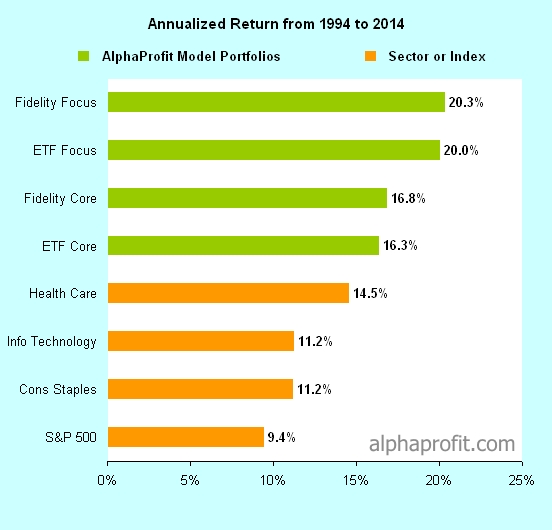Some investors are reluctant to engage in sector investing, as they view it to be riskier than index investing. Active investors now have the means to lessen the risk associated with sector investing and earn greater rewards than with index investing.
Investors often perceive sector investing as risky. Sector funds or sector ETFs that confine their investments to a specific sector or industry are often more volatile than diversified funds or ETFs.
Stocks in a specific sector often tend to move together. Economic, regulatory, or political developments can affect the prospects of many companies in a sector positively or negatively. For example, medical delivery companies in general benefit from insurance subsidies and improving accessibility to health care.
Countering the perception of sector investing being risky, a recent study by Archan Basu and Dirk Hofschire at Fidelity Investments shows investors can improve their portfolios from diversification and risk-adjusted return considerations by thinking cyclically and adopting sector investing.
They say diversification and return benefits of sector investing stem from three factors:
Wide difference in performance: The difference in performance between the best and worst performing sectors is often large. AlphaProfit’s analysis of Fidelity Select Funds shows the year’s best Fidelity Select Fund outperformed the year’s worst Fidelity Select Fund by 80% or 8000 basis points on average since 1991. This wide difference in performance across sectors enhances the potential for diversification and provides opportunity for investors to add value to their portfolios.
Enduring volatility patterns: Some sectors are consistently more risky than other sectors. For example, information technology is reliably more volatile than consumer staples. AlphaProfit’s analysis shows Fidelity Select Technology’s (FSPTX) standard deviation in quarterly returns is higher than Fidelity Select Consumer Staples’ (FDFAX) standard deviation in all rolling five-year periods from 1991 to 2014.
Stable classification: The makeup of companies within a sector tends to be stable compared to style and size based classifications. Growth stocks for example can become value stocks when they fall out of favor. Likewise, small-cap stocks can become mid-cap or large-cap stocks from price appreciation. In contrast, changes to a company’s sector classification are relatively rare.
Fidelity’s research shows sectors explain 22% of the difference in return across U. S. stocks. Style and size in comparison explain only 13% and 4%, respectively. In other words, sectors account for return differences more than style and size combined.
Investment Process to Harness the Potential of Sector Investing while Mitigating Risks
Basu and Hofschire recommend using insights on cycles and sectors to construct portfolios. They also urge investors to ensure the resilience of portfolios to a wide range of potential economic scenarios over an intermediate-time horizon. They however do not offer guidance on how to construct such portfolios.
To put cycles and sectors to work, investors need processes and tools to determine the mix of attractive sectors in the context of the business cycle. Investors need answers to questions like:
- What stage of the business cycle is the economy currently in? Is the economy contracting, bottoming, expanding, or peaking?
- What will drive growth in revenues and earnings in a specific sector?
- How cheap or expensive are stocks in a specific sector from a historical perspective and relative to the market?
- What are the risks of investing in this sector?
- How are stocks in this sector faring currently?
AlphaProfit’s Sector Investing System
AlphaProfit’s sector investing system includes a process for sector selection and a strategy for sector rotation.
AlphaProfit’s sector selection process evaluates sectors on valuation, momentum, and news quality measures.
Using sectors favorably ranked by this selection process, AlphaProfit constructs different model portfolios for its Premium Service subscribers. AlphaProfit provides the ETF Core and Fidelity Core model portfolios for long-term capital appreciation and the ETF Focus and Fidelity Focus model portfolios for aggressive growth.
AlphaProfit’s sector rotation strategy introduces or retains prospective leaders and eliminates or reduces prospective laggards from the model portfolios in a timely manner.
AlphaProfit’s sector investing system has navigated through both favorable and unfavorable market environments with a 75% success rate in picking winners.
This success rate has helped the ETF Core, Fidelity Core, ETF Focus, and Fidelity Focus model portfolios to gain at annualized rates of 16.3%, 16.8%, 20.0%, and 20.3%, respectively from 1994 to 2014. For comparison purposes, the S&P 500 has advanced at a 9.4% annual rate during the same period.
Source: Morningstar, AlphaProfit
Timely sector selection and sector rotation has enabled AlphaProfit’s Fidelity Focus, ETF Focus, Fidelity Core, and ETF Core model portfolios to beat leading Fidelity sector funds in health care, information technology, and consumer staples as well as the S&P 500.
AlphaProfit’s Premium Service has consistently ranked #1 among mutual fund investment newsletters by Hulbert Financial Digest, a Dow Jones publication that serves as de facto Consumer Reports of investment newsletters.
AlphaProfit’s Free Investment Newsletter MoneyMatters
Get two special reports Five Smart Ways of Using Fidelity Select Funds and Avoid Three Common Mistakes ETF Investors Make when you sign up for AlphaProfit’s FREE investment newsletter MoneyMatters

 Sick buying high & selling low? Fed up of the fees you pay? Tired researching investments? End your financial pain now. You have the opportunity to
Sick buying high & selling low? Fed up of the fees you pay? Tired researching investments? End your financial pain now. You have the opportunity to 


 DEC. 1993 to DEC. 2023
DEC. 1993 to DEC. 2023





